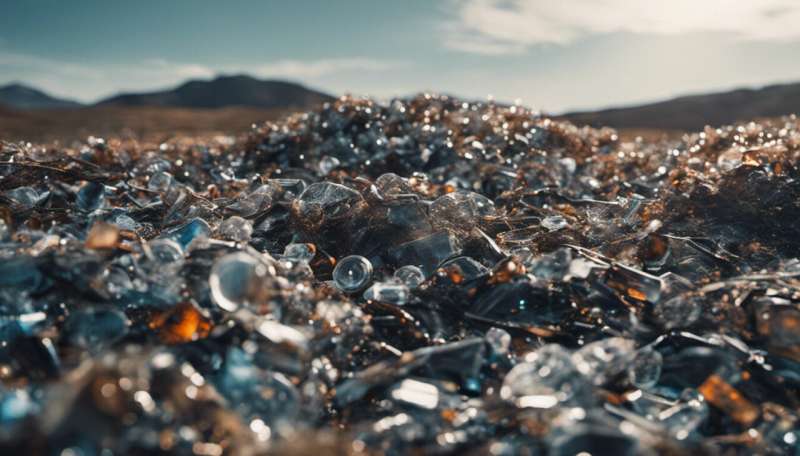This article has been reviewed according to Science X's editorial process and policies. Editors have highlighted the following attributes while ensuring the content's credibility:
fact-checked
trusted source
written by researcher(s)
proofread
Recycling: what you can and can't recycle and why it's so confusing

When it comes to recycling are you a wishcycler? No, I didn't know what this term meant until recently either—apparently it's when people try to recycle items that should be thrown away instead. And the government are trying to crack down on it.
New rules
will ask people to stop "over-
Many commonly recycled items either need specialist recycling treatment or are so contaminated that they cannot be processed properly. Think toothpaste tubes, takeaway packaging and juice cartons. So if you're sticking these items in the recycling bin or box, you might want to rethink how you're disposing of them.
Three years ago the UK government outlined its goal of recycling—setting the target for 65% of all household waste to be recycled by 2035—with no more than 10% of this waste ending up in landfill.
But a recent survey shows that 80% of UK households are "still unclear" on how to recycle effectively—does it need washing out, can I flatten items and what if the cardboard gets wet? (Wet cardboard is a no on the recycling front I'm afraid).
It's no wonder that many admit it's easier just to throw something in the bin instead of working out if it can be recycled.
Waste not
My team and I are researching how new bio-based and biodegradable plastics can contribute to a more circular economy (this is where items are reused and not sent to landfill or shipped abroad. While huge strides are being made in this area, we are still some way off all packaging being made in this way in a cost-effective manner. And so for now recycling is the next best option.
So then why the confusion about recycling? One of the main issues is there are differences in how recycling waste is collected across the UK—this can even be the case from one street to another.
For anyone confused by recycling rules, the advice is always "check with your local authority". Households should have been sent a leaflet that explains what can be recycled and how. But if you've thrown yours away—or perhaps recycled it—the information should also be on your local authorities' website.
Typically though, plastic containers such as bottles, food trays, margarine tubs and yogurt pots are readily recycled. So too is aluminum foil, cans, glass bottles and jars. But again, if you want to optimize your council's existing recycling infrastructure check your local collection guides.
One of the main reasons there are currently variations in what different authorities do or don't recycle is based on what the waste management companies they use to recyclable waste after it's collected. And this differs area to area.
Crisp packets, for example, cannot typically be recycled via household collections (though in some places they can be). This is because they require complex processes to break them down because they are made of multiple layers of plastic and metallic. Instead, you're advised to take them to your local supermarket as most chains now allow customers to recycle crisp packets and soft plastics at larger superstores.
Recycling tips
As with crisp packets and soft plastics, things such as pet food pouches can be recycled too but again not typically via your household collections—instead, these can often go to larger supermarkets for recycling.
Most greasy plastic takeaway packaging can be recycled, too. But it's a good idea to rinse them to avoid contamination during the recycling process (and to stop your bin smelling in between collections).
Perhaps the biggest problem is with greasy pizza boxes. Due to the way that paper and cardboard are recycled, it's much more difficult to remove contamination from food, so it's often best to throw contaminated pizza boxes in the general waste bin. You could always cut off the lid of the pizza box and recycle that.
As to what you can't recycle, one of the biggest issues that could easily be solved is the black plastic trays that many manufacturers use purely as a marketing tool to enhance the visual attractiveness of their products such as steak or even broccoli.
While this tactic might help to sell more units, it, unfortunately, means that these recyclable plastic trays are far less likely to actually be recycled. This is because opaque trays cannot be sorted from other types of plastic in a recycling facility as light cannot pass through them.
Thankfully, we are seeing fewer and fewer black plastic trays in our supermarkets and some advances have been made meaning that some black plastics can now be recycled. Still unsure? Again, the recurring message is to "check with your local authority". Or better yet, make a list of what can and can't be recycled in your area and stick it somewhere you can easily see.
Although it definitely isn't a case of the more the merrier when it comes to recycling, the better we are as a society at dealing with our waste and not just sending it to landfill, the better our air and environment will be for us and future generations.
Provided by The Conversation
This article is republished from The Conversation under a Creative Commons license. Read the original article.![]()

















